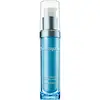What's inside
What's inside
 Key Ingredients
Key Ingredients

 Benefits
Benefits

 Concerns
Concerns

No concerns
 Ingredients Side-by-side
Ingredients Side-by-side

Water
Skin ConditioningGlycerin
HumectantDiglycerin
HumectantPropanediol
SolventPanthenol
Skin ConditioningButylene Glycol
HumectantPentylene Glycol
Skin ConditioningXylitol
HumectantMethylpropanediol
SolventPolyglyceryl-10 Laurate
Skin ConditioningBetaine
HumectantGlyceryl Glucoside
HumectantCaprylic/Capric Triglyceride
MaskingSqualane
EmollientCaprylyl Glycol
EmollientCarbomer
Emulsion StabilisingTromethamine
BufferingHydrogenated Lecithin
EmulsifyingXanthan Gum
EmulsifyingAdenosine
Skin ConditioningEthylhexylglycerin
Skin ConditioningTrehalose
HumectantSodium PCA
HumectantCeramide NP
Skin ConditioningGlucose
HumectantSerine
MaskingSodium Hyaluronate Crosspolymer
HumectantHydrolyzed Glycosaminoglycans
HumectantPotassium Phosphate
BufferingSodium Hyaluronate
HumectantCI 14700
Cosmetic ColorantBenzyl Glycol
SolventHydrolyzed Hyaluronic Acid
HumectantTocopherol
AntioxidantHyaluronic Acid
HumectantWater, Glycerin, Diglycerin, Propanediol, Panthenol, Butylene Glycol, Pentylene Glycol, Xylitol, Methylpropanediol, Polyglyceryl-10 Laurate, Betaine, Glyceryl Glucoside, Caprylic/Capric Triglyceride, Squalane, Caprylyl Glycol, Carbomer, Tromethamine, Hydrogenated Lecithin, Xanthan Gum, Adenosine, Ethylhexylglycerin, Trehalose, Sodium PCA, Ceramide NP, Glucose, Serine, Sodium Hyaluronate Crosspolymer, Hydrolyzed Glycosaminoglycans, Potassium Phosphate, Sodium Hyaluronate, CI 14700, Benzyl Glycol, Hydrolyzed Hyaluronic Acid, Tocopherol, Hyaluronic Acid
Water
Skin ConditioningGlycerin
HumectantDimethicone
EmollientButylene Glycol
HumectantNeopentyl Glycol Diheptanoate
EmollientAluminum Starch Octenylsuccinate
AbsorbentIsododecane
EmollientDimethiconol
EmollientAmmonium Acryloyldimethyltaurate/Vp Copolymer
Ethylhexylglycerin
Skin ConditioningBenzyl Alcohol
PerfumingSodium Lactate
BufferingCetearyl Olivate
Bisabolol
MaskingChlorphenesin
AntimicrobialSorbitan Olivate
EmulsifyingSodium PCA
HumectantParfum
MaskingSodium Hyaluronate
HumectantAcrylates/C10-30 Alkyl Acrylate Crosspolymer
Emulsion StabilisingSorbitol
HumectantChondrus Crispus Extract
Skin ConditioningSodium Hydroxide
BufferingProline
Skin ConditioningPortulaca Oleracea Extract
Skin ConditioningPropylene Glycol
HumectantCitric Acid
BufferingMagnesium Aspartate
Skin ConditioningZinc Gluconate
Skin ConditioningCopper Gluconate
Skin ConditioningWater, Glycerin, Dimethicone, Butylene Glycol, Neopentyl Glycol Diheptanoate, Aluminum Starch Octenylsuccinate, Isododecane, Dimethiconol, Ammonium Acryloyldimethyltaurate/Vp Copolymer, Ethylhexylglycerin, Benzyl Alcohol, Sodium Lactate, Cetearyl Olivate, Bisabolol, Chlorphenesin, Sorbitan Olivate, Sodium PCA, Parfum, Sodium Hyaluronate, Acrylates/C10-30 Alkyl Acrylate Crosspolymer, Sorbitol, Chondrus Crispus Extract, Sodium Hydroxide, Proline, Portulaca Oleracea Extract, Propylene Glycol, Citric Acid, Magnesium Aspartate, Zinc Gluconate, Copper Gluconate
Ingredients Explained
These ingredients are found in both products.
Ingredients higher up in an ingredient list are typically present in a larger amount.
Butylene Glycol (or BG) is used within cosmetic products for a few different reasons:
Overall, Butylene Glycol is a safe and well-rounded ingredient that works well with other ingredients.
Though this ingredient works well with most skin types, some people with sensitive skin may experience a reaction such as allergic rashes, closed comedones, or itchiness.
Learn more about Butylene GlycolEthylhexylglycerin (we can't pronounce this either) is commonly used as a preservative and skin softener. It is derived from glyceryl.
You might see Ethylhexylglycerin often paired with other preservatives such as phenoxyethanol. Ethylhexylglycerin has been found to increase the effectiveness of these other preservatives.
Glycerin is already naturally found in your skin. It helps moisturize and protect your skin.
A study from 2016 found glycerin to be more effective as a humectant than AHAs and hyaluronic acid.
As a humectant, it helps the skin stay hydrated by pulling moisture to your skin. The low molecular weight of glycerin allows it to pull moisture into the deeper layers of your skin.
Hydrated skin improves your skin barrier; Your skin barrier helps protect against irritants and bacteria.
Glycerin has also been found to have antimicrobial and antiviral properties. Due to these properties, glycerin is often used in wound and burn treatments.
In cosmetics, glycerin is usually derived from plants such as soybean or palm. However, it can also be sourced from animals, such as tallow or animal fat.
This ingredient is organic, colorless, odorless, and non-toxic.
Glycerin is the name for this ingredient in American English. British English uses Glycerol/Glycerine.
Learn more about GlycerinSodium Hyaluronate is hyaluronic acid's salt form. It is commonly derived from the sodium salt of hyaluronic acid.
Like hyaluronic acid, it is great at holding water and acts as a humectant. This makes it a great skin hydrating ingredient.
Sodium Hyaluronate is naturally occurring in our bodies and is mostly found in eye fluid and joints.
These are some other common types of Hyaluronic Acid:
Learn more about Sodium HyaluronateSodium PCA is the sodium salt of pyroglutamic acid. It is naturally occurring in our skin's natural moisturizing factors where it works to maintain hydration.
The PCA stands for pyrrolidone carboxylic acid, a natural amino acid derivative.
This ingredient has skin conditioning, anti-inflammatory, and humectant properties. Humectants help hydrate your skin by drawing moisture from the air. This helps keep your skin moisturized.
Learn more about Sodium PCAWater. It's the most common cosmetic ingredient of all. You'll usually see it at the top of ingredient lists, meaning that it makes up the largest part of the product.
So why is it so popular? Water most often acts as a solvent - this means that it helps dissolve other ingredients into the formulation.
You'll also recognize water as that liquid we all need to stay alive. If you see this, drink a glass of water. Stay hydrated!
Learn more about Water